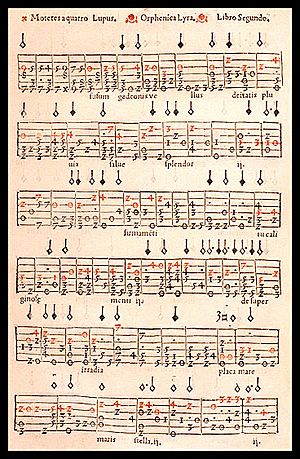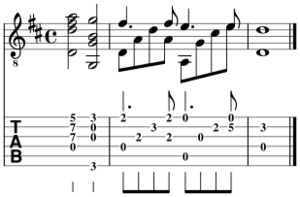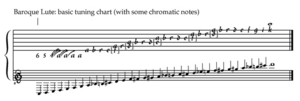Tablature facts for kids

Tablature (or tab for short) is a special way of writing music. Instead of showing musical notes, it tells you where to put your fingers on an instrument. It's like a map for your hands!
Tablature is very common for instruments with frets, like the guitar, lute, or vihuela. It's also used for some wind instruments, like the harmonica. Tablature was popular a long time ago, during the Renaissance and Baroque periods. It's still widely used today for many types of music.
To tell the difference, regular music writing is often called "staff notation."
Contents
What Does "Tablature" Mean?
The word tablature comes from the Latin word tabulatura. The Latin word tabula means a table or a slate. So, to "tabulate" something means to put it into a table or a chart. This makes sense because tablature often looks like a chart!
Where Did Tablature Come From?
The first time we know of tablature being used in Europe was around the year 1300. It was first used to write music for the organ.
How Tablature Works
Regular music notation shows you the exact sound (pitch) of each note and how long to hold it. Tablature is different. It tells you *what to do* to make a note. It shows you where to place your fingers on the instrument and when to do it.
For string instruments, tablature often looks like a simple drawing of the strings and frets. For keyboard instruments, it shows the keys. For wind instruments, it shows which fingerholes to cover or leave open.
French Lute Tablature
French lute tablature uses lines to represent the strings of the lute. The top line is the highest string, and the bottom line is the lowest string.
F____________________ D____________________ A____________________ F____________________ D____________________ A____________________
Small letters are placed on these lines to show which note to play.
- If you see an 'a' on a line, it means play that string without pressing any frets (an open string).
- A 'b' means press the first fret.
- A 'c' means press the second fret, and so on.
- The letter 'j' was not used.
Here's an example:
F_____c___ D_____a___ A_____b___ F_____c___ D_____a___ A_____b___ G - a
This example would show a G-minor chord on a Renaissance lute.
If all strings are open, it might look like this:
F______a________ D______a________ A______a________ F______a________ D______a________ A______a________ D- ///a
This would represent a D-minor chord.
For strings below the main six, extra short lines are used below the main staff. These strings are tuned differently for each song.
German Lute Tablature
German lute tablature has been around since the 1400s. It's believed that a blind organ player named Conrad Paumann invented it. This type of tablature was used in German-speaking countries until the late 1500s.
Computer Programs for Tablature
There are many computer programs that help you write tablature. Some of these programs can also write lyrics, guitar chord diagrams, and even regular music notation. You can also create simple tablature files using a basic word processor. Just make sure to use a font where all letters and spaces have the same width, like 'Courier New'. This helps everything line up correctly.
Guitar Tablature
Guitar tablature is used for both acoustic and electric guitars, which usually have six strings. A simpler version with four strings is used for bass guitar. You'll often find guitar and bass tab in songbooks, especially for pop, rock, folk, and country music. It's also common in teaching books and on websites. Sometimes, music written in tablature is just called "tabs."
The same style of tablature is also used for other instruments with frets, like the banjo, mandolin, and ukulele.
In guitar tablature, lines represent the strings. The top line usually means the thinnest string (high E string). The bottom line means the thickest string (low E string). Sometimes, the lines are numbered 1 to 6 instead of using letters. Number 1 is the high E string, 2 is the B string, and so on.
The numbers on the lines tell you which fret to press. For example, a "3" on the top line means press the third fret on the high E string. A "0" means play the string open (without pressing any frets).
If you use a capo, the numbers still tell you the fret number *from the capo*, not from the very end of the guitar neck. For chords, a letter above or below the tablature shows the main note of the chord.
Examples of Guitar Tablature:
Here are the chords E, F, and G in a simple text format:
e|---0---1---3---
B|---0---1---0---
G|---1---2---0---
D|---2---3---0---
A|---2---3---2---
E|---0---1---3---
E F G

Tablature can also use different symbols to show special guitar techniques, like bends, hammer-ons, and slides. Here are some common symbols:
| Symbol | Technique |
|---|---|
| h | hammer on (hit a note with your finger) |
| p | pull off (pull your finger off a note) |
| b | bend string up (push the string up to change its pitch) |
| r | release bend (let the bent string go back) |
| / | slide up (slide your finger up the string) |
| \ | slide down (slide your finger down the string) |
| v | vibrato (wiggle the string to make the note waver) |
| s | legato slide (smooth slide between notes) |
| * | natural harmonic (a special ringing sound) |
| tr | trill (quickly play two notes back and forth) |
| PM | palm muting (muffle the strings with your palm) |
| x | muted slash (a dead, percussive sound) |
Sometimes, symbols are added above the tablature to show how long each note should be played:
| Symbol | Note Length |
|---|---|
| W | Whole note (a long note) |
| H | Half note (half as long as a whole note) |
| Q | Quarter note (half as long as a half note) |
| E | Eighth note (half as long as a quarter note) |
| . | Dotted note (makes the note longer) |
Keep in mind that guitar tablature isn't always the same. Different books or magazines might use slightly different symbols. They usually include a guide to explain what their symbols mean.
Harmonica Tablature
Harmonica tablature tells you which hole to blow into or draw from, and if you need to bend a note.
For example, on a "C" harmonica:
Unbent Bent lv1 Bent lv2 Bent lv3 3i (B) 3i| (Bb) 3i|| (A) 3i||| (G#)
- "i" usually means to draw (breathe in).
- "e" or no symbol means to blow (breathe out).
- Lines or apostrophes after the number show how much to bend the note.
Here's a simpler system for diatonic harmonicas:
2 = blow the 2 hole -2 = draw the 2 hole -2' = draw the 2 hole with a half bend -2" = draw the 2 hole with a full bend
For chords (playing multiple notes at once), the numbers are grouped, often with parentheses: (2 3) = blow the 2 hole and the 3 hole at the same time
For chromatic harmonicas (which have a button):
2 = blow the 2 hole -2 = draw the 2 hole <2 = blow the 2 hole with the button in <-2 = draw the 2 hole with the button in
Here is an example of harmonica tablature for the song "Mack the Knife": C Diatonic
5 6 -6 -6 5 6 -6 -6 Oh the shark has pretty teeth, dear -4 -5 -6 -6 -4 -5 -6 And he shows them pearly white 6 -7 -8 7 -7 -6 7 -4 Just a jack knife has MacHeath, dear 5 -5 7 -4 7 -7 -6 And he keeps it out of sight
See also
 In Spanish: Tablatura para niños
In Spanish: Tablatura para niños
- ASCII tab
- Digital sheet music
- Drum tablature
- Fret
- Keyboard tablature
- Musical notation
- Shamisen tablature




